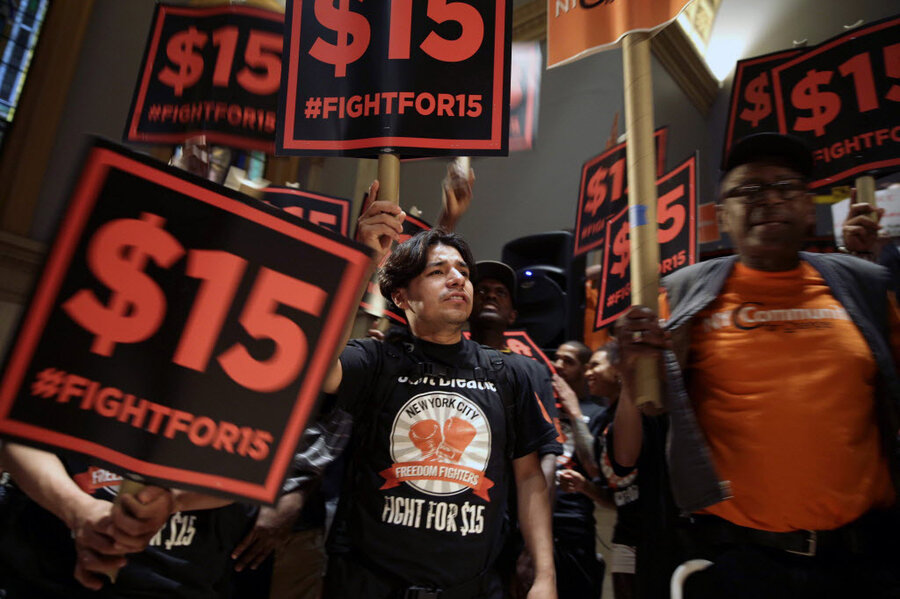Is $15 minimum wage coming to a city near you?
Loading...
This week saw minimum wage increases on both sides of the country as the University of California system announced on Wednesday that it would raise minimum wages to $15 an hour. This follows New York state’s proposed plan of a minimum $15 hourly wage for fast-food workers.
The University of California would be the nation’s first public university to adopt a $15 minimum wage. With 10 schools and 240,000 students, it’s the state’s third-largest employer. According to the University, about 3,200 UC workers, plus a much larger but currently unknown number of outside contractors, will receive the higher wage.
“How we support our workers and their families impacts Californians who might never set foot on one of our campuses,” said UC President Janet Napolitano, who previously served as US Secretary of Homeland Security under President Obama.
“It’s the right thing to do,” she said.
The University of California is one of several public universities to adopt higher minimum wages for its employees, though none has yet set a wage as high as $15 per hour. California’s statewide minimum wage is $9.00 an hour.
Cities across the West Coast, including Seattle, Los Angeles, San Francisco, and Oakland, have voted to phase in an increased minimum wage. Washington, D.C. legislators have proposed a ballot to raise the city’s minimum wage to $15 an hour in 2016, which would make it the first East Coast city with that increased minimum wage.
The $15 per hour number is one that’s been held up by labor groups as today’s livable wage. Currently, the federal minimum wage sits at $7.25 an hour, or roughly $15,000 annually for full-time work. Many proponents of increased minimum wages assert that the current standard is not enough to survive in today’s America.
“You cannot live and support a family on $18,000 a year in the state of New York – period,” said New York Governor Andrew Cuomo in support of the state’s increased minimum wage proposal for fast-food workers. The current New York state minimum wage is $8.75 an hour.
Minimum wages across the country has wide variance: Washington, D.C. has the highest, at $10.50, while Oklahoma’s minimum wage is $2.00 for many business exempt from federal labor standards. Oklahoma has even passed laws barring counties or cities from passing minimum wages above the federal level. Other states have passed similar laws. Other states, like Connecticut or Maine, have state minimum wages set as a proportion greater than or equal to the federal standard.
But that establishment of minimum wage greater than the federal standard is complicated and may not apply to all workers.
In fact, workers in many states make far less than minimum wage. Workers covered under the federal Fair Labor Standards Act are required to be paid the federal wage of $7.25 an hour, but because the FLSA does not apply to all workers in all industries, many are paid less than that. Full exemptions to minimum wage laws and FLSA can be found on the Department of Labor’s website.
Several politicians, including presidential hopeful Hillary Clinton, support an increased and more regulated federal minimum wage. Vice President Joe Biden promoted a higher minimum wage in Los Angeles when he visited the city last week, according to the Associated Press.
Wage hikes could be “life-changing,” the Vice President said.
Supporters of an increased minimum wage believe that it could help lift the working poor into the middle class, in an age where many see problems of income inequality and a shrinking middle class. Proponents argue that increasing the money in a person’s pocket puts money directly into the economy. But for many making minimum wage, the current paycheck is not enough.
“If I made $15, I could pay my rent on time,” Rebecca Cornick tells the Associated Press. Ms. Cornick works at a Wendy’s restaurant in Brooklyn where she makes $9.00 an hour – still above the state’s minimum wage. “I could put food on the table, I could hold my head up.”
Opponents of minimum wage hikes argue that they could hurt businesses, forcing many to fire workers and increase prices to compensate. To some, proposed wage increases are detrimental to certain businesses.
“Singling out fast-food restaurants while ignoring other industries that hire workers who are paid under $15 is unfair and discriminatory,” Jack Bert, who owns seven McDonald’s restaurants in New York City, tells the Associated Press.
For some businesses, especially fast-food restaurants in New York, complaints against wage increases may be brought to court.
There are 200,000 fast-food workers in New York who would benefit from an increased minimum wage, according to the Associated Press.
“This is just the beginning,” said Gov. Cuomo. “We will not stop until we reach true economic justice.”
This report contains material from the Associated Press.








